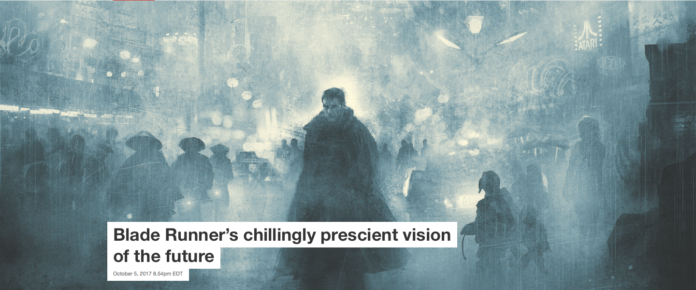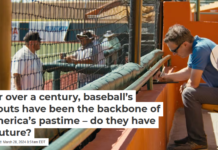
Marsha Gordon, North Carolina State University
Can corporations become so powerful that they dictate the way we feel? Can machines get mad – like, really mad – at their makers? Can people learn to love machines?
These are a few of the questions raised by Ridley Scott’s influential sci-fi neo-noir film “Blade Runner” (1982), which imagines a corporation whose product tests the limits of the machine-man divide.
Looking back at the original theatrical release of “Blade Runner” – just as its sequel, “Blade Runner 2049” opens in theaters – I’m struck by the original’s ambivalence about technology and its chillingly prescient vision of corporate attempts to control human feelings.
From machine killer to machine lover
Even though the film was tepidly received at the time of its release, its detractors agreed that its imagining of Los Angeles in 2019 was wonderfully atmospheric and artfully disconcerting. Looming over a dingy, rain-soaked City of Angels is Tyrell Corporation, whose namesake, Dr. Tyrell (Joe Turkel), announces, “Commerce is our goal here at Tyrell. More human than human is our motto.”
Tyrell creates robots called replicants, which are difficult to differentiate from humans. They are designed to be worker-slaves – with designations like “combat model” or “pleasure model” – and to expire after four years.
Batty (Rutger Hauer) and Pris (Darryl Hannah) are two members of a small cohort of rebelling replicants who escape their enslavement and hope to extend their lives beyond the four years allotted them by their makers. These replicant models even possess fake memories, which Tyrell implanted as a way to buffer the machine’s anxieties. Instead, the memories create a longing for an unattainable future. The machines want to be treated like people, too.
Deckard (Harrison Ford), a policeman (and maybe a replicant too), is tasked with eliminating the escaped machines. During his search, he meets a special replicant who lacks the corporate safeguard of a four-year lifespan: the beautiful Rachael (Sean Young), who shoots and kills one of her own in order to save Deckard. This opens the door for Deckard to acknowledge growing feelings towards a machine who has developed the will to live and love beyond the existence imagined for her by Tyrell Corp.
The greatest challenge to Deckard comes from combat model Batty, who has demonstrably more passion for existence than the affectless Deckard.
The film’s climax is a duel to the death between Deckard and Batty, in which Batty ends up not just sparing but saving Deckard. As Deckard watches Batty expire, he envies the replicant’s lust for life at the very moment it escapes him. Batty seems more human than the humans in this world, but Tyrell’s motto is both clue and trap.
Deckard’s end-of-film decision to escape with Rachael defies the rules of the corporation and of society. But it’s also an acknowledgment of the successful, seamless integration of machine and human life.
“Blade Runner” imagines a world in which human machines are created to serve people, but Deckard’s interactions with these replicants reveals the thinness of the line: He goes from being on assignment as a machine killer to falling in love with a machine.
A world succumbing to machines
Today, the relationship between corporations, machines and humans defines modern life in ways that Ridley Scott – even in his wildest and most dystopic imagination – couldn’t have forecast in 1982.
In “Blade Runner,” implanted memories are propped up by coveted (but fake) family photos. Yet a world in which memory is fragile and malleable seems all too possible and familiar. Recent studies have shown that people’s memories are increasingly susceptible to being warped by social media misinformation, whether it’s stories of fake terrorist attacks or Muslims celebrating after 9/11. When this misinformation spreads on social media networks, it can create and reinforce false collective memories, fomenting a crisis of reality that can skew election results or whip up small town hysteria.
Meanwhile, Facebook has studied how it can manipulate the way its users feel – and yet over a billion people a day log on to willingly participate in its massive data collection efforts.
Our entrancement with technology might seem less dramatic than the full-blown love affair that Scott imagined, but it’s no less all-consuming. We often prioritize our smartphones over human social interactions, with millennials checking their phones over 150 times a day. In fact, even as people increasingly feel that they cannot live without their smartphones, many say that the devices are ruining their relationships.
And at a time when we’re faced with the likelihood of being unable to differentiate between what’s real and what’s fake – a world of Twitter bots and doctored photographs, trolling and faux-outrage, mechanical pets and plastic surgery – we might be well served by recalling Deckard’s first conversation upon arriving at Tyrell Corp. Spotting an owl, Deckard asks, “It’s artificial?” Rachael replies, not skipping a beat, “Of course it is.”
In “Blade Runner,” reality no longer really matters.
![]() How much longer will it matter to us?
How much longer will it matter to us?
Marsha Gordon, Professor of Film Studies, North Carolina State University
This article was originally published on The Conversation. Read the original article.




















